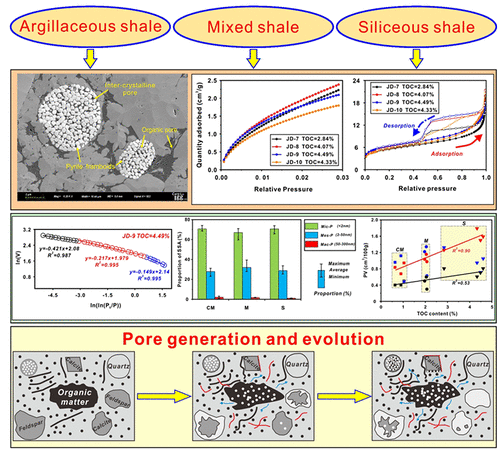当前位置:
X-MOL 学术
›
Energy Fuels
›
论文详情
Our official English website, www.x-mol.net, welcomes your
feedback! (Note: you will need to create a separate account there.)
Variations of Pore Structure in Organic-Rich Shales with Different Lithofacies from the Jiangdong Block, Fuling Shale Gas Field, SW China: Insights into Gas Storage and Pore Evolution
Energy & Fuels ( IF 5.2 ) Pub Date : 2020-09-23 , DOI: 10.1021/acs.energyfuels.0c02529 Aoqi Jia 1 , Dongfeng Hu 2 , Sheng He 1 , Xiaowen Guo 1 , Yuguang Hou 1 , Tao Wang 1 , Rui Yang 1
Energy & Fuels ( IF 5.2 ) Pub Date : 2020-09-23 , DOI: 10.1021/acs.energyfuels.0c02529 Aoqi Jia 1 , Dongfeng Hu 2 , Sheng He 1 , Xiaowen Guo 1 , Yuguang Hou 1 , Tao Wang 1 , Rui Yang 1
Affiliation

|
The pore structure of gas shale reservoirs strongly influences gas occurrence, migration, and enrichment, which has become an important fundamental issue for shale gas exploration and production. To investigate variations in the pore structure of organic-rich shale and provide some insights into gas storage and pore evolution, this study focused on three dominant types of shale lithofacies in the Wufeng (WF) and Longmaxi (LMX) Formations in the Jiangdong (JD) Block of the Fuling Shale Gas Field. To qualitatively and quantitatively characterize the nanoscale pore structure of organic shale in the WF and LMX Formations, experiments including total organic carbon (TOC) content, X-ray diffraction (XRD), high-resolution scanning electron microscopy (SEM), and low-temperature gas (nitrogen (N2) and carbon dioxide (CO2)) adsorption were conducted. Based on the N2 adsorption experiment and fractal theory, the fractal dimensions (D) of micropores (<2 nm), mesopores (2–50 nm), and macropores (50–300 nm) were respectively calculated, and the relationships between pore structure parameters and mineral composition, TOC content, and fractal dimension of shale in different lithofacies were investigated. The results show that the organic pores, inorganic pores (intergranular pores and intragranular pores), and microfractures are all developed in the WF and LMX shales. The pore morphology is dominated by slit or parallel plate pores, in addition to a few inkbottle pores. The pore size distribution (PSD) is multipeaked, and the total pore volume (PV) is mainly provided by mesopores and macropores (contribution rate is approximately 80%), while the pore specific surface area (SSA) is mainly provided by micropores (approximately 70%). Due to the various contents of clay minerals, quartz, and TOC, shale samples with different lithofacies show different pore evolution characteristics, resulting in strong heterogeneity and complex pore structure. Pores in the WF and LMX shale formations have obvious scale-dependent fractal features and are characterized by their corresponding D values for micropores, mesopores, and macropores. The D values of micropores in argillaceous shale (CM) are the largest among the shales, suggesting rougher micropore surfaces in the argillaceous shale (CM). In contrast, the D values of mesopores in mixed shale (M) and siliceous shale (S) are comparable but are larger than those of argillaceous shale (CM), indicating the much more complex mesopore structure in mixed shale (M) and siliceous shale (S), which could be conducive for gas adsorption and accumulation. The D values of macropores in siliceous shale (S) shales are relatively large and can provide a considerable amount of PV and SSA for the storage of free and adsorbed gas.
更新日期:2020-10-16











































 京公网安备 11010802027423号
京公网安备 11010802027423号